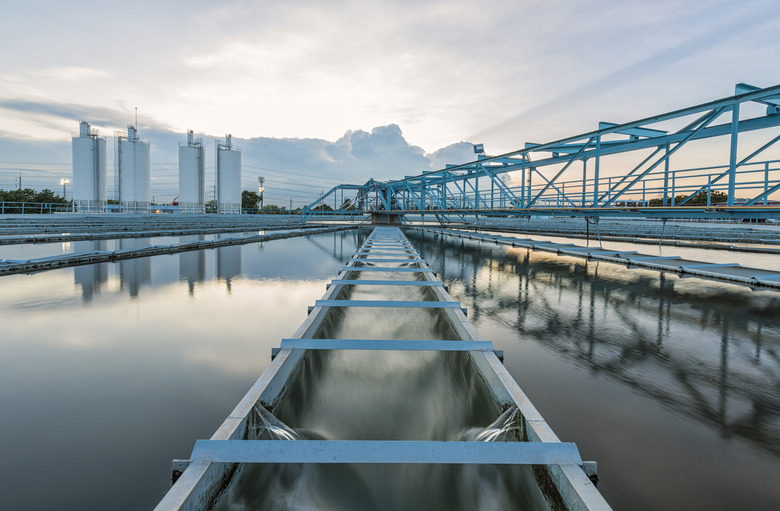How To Make A Waste Water Treatment Plant Model
Waste water treatment plants take the runoff from street drains, showers, sinks, washing machines and toilets to make it safe and clean again before releasing it back into the environment. Sewage treatment involves multiple steps and processes at the plant to make it clean and safe. Waste water plant operations convert the sewage water through processes that involve screening, settlement, aeration, sludge scraping and filtration. To build a model of a waste water treatment plant, get to know the different parts that make up the whole.
TL;DR (Too Long; Didn't Read)
Represent each of the following different stages of waste water treatment — and their connections — in a model of a waste water treatment plant using: a screen, a circular tank, a rectangular tank, another circular tank, a sand filter and an outlet to a body of water.
Screening out Large Objects and Grit
Screening out Large Objects and Grit
Large objects like diapers, feminine hygiene products, wet wipes, cotton buds, other miscellaneous garbage and the grit contained in storm water requires screening to remove the debris first. Larger screens catch and remove these objects and dispose of them in a landfill or more appropriate place.
An easy way to represent this first stage is a long inlet chamber that contains a series of screens.
Primary Treatment in a Settlement Tank
Primary Treatment in a Settlement Tank
After removing the large pollutants from the water, the next-largest pollutant in the water is solid organic waste — toilet paper and human waste. These pollutants sink to the bottom and form a sludge in a large circular settlement tank. The tank continuously scrapes away the sludge and removes from the water for further treatment.
Represent this stage in the model by a circular tank with a large scraper at the bottom, which moves like the hand of a clock as it collects sludge.
Secondary Treatment in an Aeration Lane
Secondary Treatment in an Aeration Lane
After removing most of the sludge, the next phase involves pumping the water through narrow rectangular aeration lanes. The action of aeration pumps the lanes full of dissolved air, providing an ideal environment in these highly aerobic chambers in which bacteria breaks down the remaining sludge particles in the water.
In a model, represent these aeration chambers by creating narrow rectangular chambers with holes in the bottom through which the system pipes in air.
Final Treatment in a Settlement Tank
Final Treatment in a Settlement Tank
With most of the large pollutants taken care of, the water is ready for a final treatment in a settlement tank. This is much like the first settlement tank, but not as hard-working, as there is a minimal amount of sludge remaining in the water.
Represent the final settlement tank in the same way as the first settlement tank.
Filtration Through a Bed of Sand
Filtration Through a Bed of Sand
The last tank allows water to spill over the edge and proceed through a filter of fine sand, which removes any remaining particles of pollutants. After this, the water is free to rejoin another body of water, such as a river, wetland, lake or the ocean.
Represent this stage in a variety of ways, depending on the complexity and dimensions of the project. Use a small narrow trough filled with sand with a pipe that leads the water from the second settlement tank into the trough and then to a body of water in your model.
Cite This Article
MLA
Grosfield, Lynsey. "How To Make A Waste Water Treatment Plant Model" sciencing.com, https://www.sciencing.com/make-water-treatment-plant-model-7877830/. 23 April 2018.
APA
Grosfield, Lynsey. (2018, April 23). How To Make A Waste Water Treatment Plant Model. sciencing.com. Retrieved from https://www.sciencing.com/make-water-treatment-plant-model-7877830/
Chicago
Grosfield, Lynsey. How To Make A Waste Water Treatment Plant Model last modified March 24, 2022. https://www.sciencing.com/make-water-treatment-plant-model-7877830/
